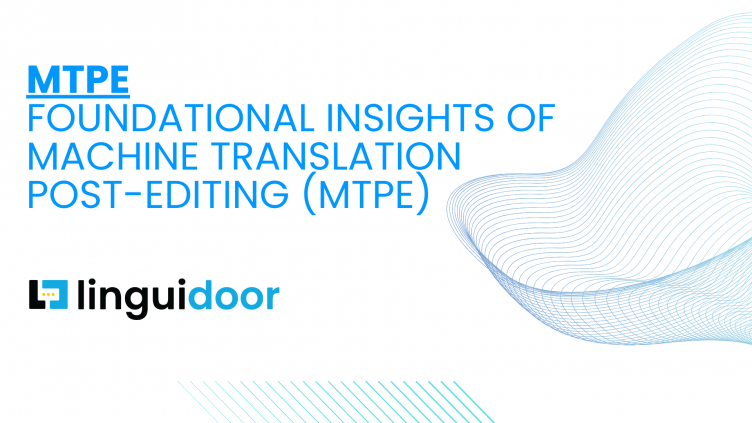Foundational Insights of Machine Translation Post Editing (MTPE)

The utilization of Machine Translation Post Editing (MTPE) has become increasingly prevalent in the world of business communication. It provides an insightful overview of MTPE, unraveling its core principles and shedding light on its transformative impact within the field of B2B communication.
Overview of Machine Translation Post Editing (MTPE)
Machine Translation Post Editing (MTPE) is a fantastic example of how technology and human expertise can team up to offer excellent results. As machine translation ensures you receive quick results, human linguists ensure the output is error-free in every possible way. It is cost-effective and reasonable, with no compromise on quality. Plus, its presence in B2B communication ensures everyone is on the same page.
Significance of Quality Assurance in B2B Communication
Quality Assurance makes sure that there is a seamless verbal exchange within the corporate realm, giving importance to accuracy, consistency, and contextual relevance. While carrying out the process of Machine Translation Post Editing (MTPE), quality assurance guarantees the overall quality of the translated content is pristine. It not only helps make the content flawless but also ensures that the business dialogue resonates universally across diverse audiences.
Foundations of Quality Assurance in MTPE
To have a solid foundation of QA in B2B communication, linguists must opt for a systematic approach, meticulously analyze source materials, tailor translations to industry nuances, and give clarity the utmost importance. The results will make sure that the translations are an amalgamation of facts, cultural resonance, and no blatant flaws. The section below navigates through the core elements that constitute this foundation, beginning with exploring the fundamental role of Machine Translation (MT) in B2B communication.
A. Understanding the Role of MT in B2B Communication
In the B2B world, Machine Translation (MT) makes sure that businesses from across the world understand each other better. Its primary function is to translate content from one language to another, facilitating seamless interaction between businesses that speak different languages. Think of it as a boat that helps companies sail through the big sea of language barriers and take them ashore to smoother, more critical conversations.
1. Machine Translation (MT) in Business Settings
If a business aims to make its name in untapped global markets, Machine Translation will help you effectively speak the target audience’s language. It enhances international collaboration, boosts operational efficiency, enables cost-effective communication, and supports market expansion and real-time translation needs. Tools like Microsoft Translator, Amazon, and Google Translate can work on large volumes of text with a quick turnaround time. Combined with the nuances and cultural subtleties of human translation, you will have immaculate content that ensures effective communication with international customers.
Benefits and Challenges of MT in B2B Communication
While acknowledging the dual nature of technology, let’s conduct a balanced examination of the benefits and challenges associated with MT in the context of B2B communication.
Benefits
MT in a B2B interaction helps you speed up translations with additional perks of efficiency and cost-saving. For instance, if a Spanish company seeks to engage with a Japanese counterpart, MT expedites the translation process, establishing a cost-effective means for cross-cultural communication.
Challenges
Machine Translation Post Editing can struggle with the delicate intricacies of a language, compromising accuracy. For instance, a phrase with a distinct meaning in French may lose its essence in translation. So, while MT is a game changer, it’s not perfect and may need post editing to rectify these discrepancies and refine the translated content.

B. The Essence of Post-Editing
Try visualizing Machine Translation (MT) as a speedy sketch artist quickly drawing the basic idea—a simple outline. Now, think of Post-editing as the experienced illustrator who steps in to add details, depth, and clarity to the sketch. It’s like turning a rough idea into a beautiful, detailed masterpiece, don’t you think? Thus, Post-editing is vital for transforming the initial concept into a refined and polished masterpiece of communication, ensuring clarity and effectiveness.
1. Defining Post-Editing in Translation Processes
Post-editing is a significant step in the translation process, where the editor refines and enhances machine-generated content. They play a pivotal role in this phase, guided by clear objectives and benchmarks. Post-editing involves addressing linguistic errors, adjusting sentence structures, and ensuring the quality of the entire translation meets the high standards required for professional communication.
2. Post-Editing vs. Traditional Translation Approaches
Drawing a sharp contrast, we explore how post-editing diverges from traditional translation methods. For example, in a traditional approach, a translator might spend a significant amount of time translating a document from one language to another, building the entire translation from the ground up. In contrast, Machine Translation post editing optimizes efficiency by working with the output of machine translation, focusing on enhancements rather than a complete overhaul. Post-editing works as per the demands of swift communication, offering advantages in terms of speed, cost-effectiveness, and adaptability.
Preparing for Success: Pre-Editing Considerations
As we venture into the world of Machine Translation Post Editing (MTPE), being prepared is crucial for a job well done. This section dives into the nitty-gritty of pre-editing, focusing on the first step:
A. Source Text Analysis
To kick off pre-editing on the right foot, we start by closely examining the original text. This step is like putting on detective glasses – we want to uncover all the details and potential hurdles. The goal? To understand the source text really well. This is crucial for professionals dealing with B2B communication, helping them be prepared to tackle any tricky parts with the right tools in hand.
1. Assessing Source Text Complexity
Let’s break down the first step: figuring out how tricky the original text is. We take a structured approach, looking at things like specialized words for specific industries, how sentences are built, and the cultural nuances in the text. By doing this thorough examination, businesses can create customized strategies for editing that fit the specific needs of each piece of text.
2. Identifying Potential Challenges and Ambiguities
Moving beyond complexity, original texts often hide challenges and unclear parts that make post-editing difficult. The goal here is to become skilled at spotting these stumbling blocks – identifying words with multiple meanings or phrases that depend on context. Language professionals can get ahead of the game by mastering the art of finding these challenges ahead of time.
B. Customizing MT Engines for B2B Content
Customizing MT engines is like giving them a special touch to understand the unique language details in B2B communication. In simpler terms, it is making sure the machine-generated translations are just right for professional settings. This part digs into the specific adjustments needed to fine-tune MT engines, ensuring they meet the high standards expected in the business world.
1. Tailoring MT Engines to Industry-Specific Vocabulary
Making machine translation engines work seamlessly for B2B communication starts with understanding the unique vocabulary used in different industries. This section is like teaching the translation machine the specialized language, including industry terms, acronyms, and jargon specific to various business sectors. By adjusting the settings to resonate with a specific industry, businesses can ensure the machine-generated translations are accurate and perfectly in tune with the language of a particular field.
2. Addressing Domain-Specific Challenges
When it comes to B2B content, there are often domain-specific challenges to different industries that need special attention. This part explores how businesses tackle these challenges by adjusting MT engines. Therefore, whether it’s legal, technical, or financial content, the goal is to help MT engines handle the unique complexities of each field.

Crafting a Unique Approach to MTPE Quality Assurance
To achieve excellence in Machine Translation Post Editing (MTPE), having a special way of ensuring quality is super important. Below, we’ll explore the three main things that make quality assurance effective. These pillars are the strong foundation that holds up the quality of our work in Machine Translation Post Editing MTPE.
A. The Three Pillars of Effective Quality Assurance
Ensuring top-notch translations in Machine Translation Post Editing (MTPE) relies on three key pillars. Let’s explore each one:
1. Linguistic Accuracy
This is the foundation of getting the language just right. In this section, we’ll look at strategies for achieving precise language in MTPE that aligns seamlessly with the expectations in B2B communication.
A. Strategies for Ensuring Linguistic Precision
Here, we’ll delve into the toolkit of strategies that Machine Translation post-editors use to enhance linguistic accuracy. From adjusting sentence structures to refining grammar, the focus is on polishing machine-translated content to reflect human expression.
B. Handling Cultural Nuances in B2B Content
B2B communication spans different cultures, demanding awareness of details beyond language. This part guides businesses in understanding cultural subtleties effectively, ensuring that their messages resonate authentically across diverse global audiences. It’s like adjusting the language to ensure it speaks to everyone in the right way while maintaining the important details.
2. Consistency Across Translations
Consistency is like the glue that holds translated content together, making sure it matches the established brand identity and messaging standards. Let’s dive into how we maintain this uniformity across translations:
A. Establishing Terminology Guidelines
This part is all about building a solid foundation for consistent communication. We’ll explore how to create clear and precise terminology guidelines. By sticking to a set of standardized terms, businesses can make sure their brand message is strong and that important ideas are consistently conveyed in all translated materials.
B. Leveraging Translation Memory for Consistency
Translation Memory (TM) is a useful tool for keeping things consistent. Discover how businesses can use TM to store and reuse parts of text that have been translated before. This way, organizations keep the language consistent across different documents and projects. It’s like having a memory bank that ensures everyone speaks the same language, making B2B communications efficient and maintaining a unified voice.
3. Contextual Relevance
In B2B communication, context is everything, and making sure translations fit right in is crucial. Let’s explore how to achieve this contextual relevance:
A. Addressing Industry-Specific Context
Different industries have their own language and unique contextual details. This part guides us through the process of handling these industry-specific contexts in translations. By integrating sector-specific terms and understanding the nuances that matter, businesses can make sure their communication aligns with what their audience expects.
B. Adapting Tone and Style for Business Communication
The tone and style of an intended message matter a lot. We’ll delve into how to adjust them while translating to match the formalities and expectations of B2B communication. So, whether it’s legal, technical, or marketing content, aligning the language with the professional context is key for making sure the message is clear and effective.

Conclusion
In a nutshell, Machine Translation Post Editing (MTPE) is like the superhero of precise communication in the business world. We’ve explored its origins, learned how to fine-tune translation engines, and uncovered the secrets of quality assurance. As we wrap up, remember: these strategies are your superpowers for achieving top-notch translations and revolutionizing how businesses communicate globally.
It’s not just about words but a whole new level of excellence.
Transform your communication landscape with precision—try our MTPE services today!

Made up your mind yet?
Empower your globalization goals today!




